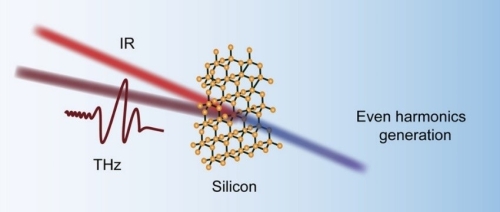Recently, a research team from Shanghai Institute of Optics and Fine Mechanics (SIOM) of the Chinese Academy of Sciences (CAS) has made a progress in the study of ultra-fast symmetry manipulation in intense THz field driven crystalline silicon. Related work was published on iScience on Feb. 18, 2022.
They irradiated Si crystal with intense pump THz beam, observed and characterized the THz-induced the second and fourth harmonics of the infrared probe. In addition, they revealed the effect of THz and Si orientation on even-order harmonics generation.
As an important semiconductor material, silicon (Si) is widely used in various fields of modern industry and information industry. However, the centrosymmetric structure of Si leads to its lack of linear electro-optic effect, which partly limits its wider application in optoelectronics.
Terahertz (THz) is a kind of electromagnetic wave with its frequency between 0.1THz and 10THz, which situates in the transition region of electronics and photonics. In addition, its photon energy is in the order of millielectron volts, which can effectively couple with phonons, spins, and so on. The structure of the material can be manipulated by intense THz when the THz electric field is up to MV/cm, and present a new state of matter.
The researchers carried out a series of activities. A thin (2μm-thick), free-standing, crystalline silicon film was exposed to intense THz fields generated by optical rectification in an organic crystal 4-N, N-dimethylamino-4’-N’-methyl-stilbazolium2, 4, 6-trimethylbenzenesulfonate (DSTMS). And the generated even order harmonics were detected by a weak copropagating 120-femtosecond-duration, 1450 nm wavelength-centered infrared probe beam. The intensity of the THz and the infrared beams on the silicon were 0.66 GW/cm2 and 61 GW/cm2 respectively. By changing the delay between the pump and the probe, the time-dependent evolution of the harmonic generation can be recorded by the optical spectrometer placed behind the Si crystal. When there was no THz presented or if the two beams were not overlapped in time, only odd-order harmonics were detected, attesting to the inversion symmetry of the silicon crystal.
This study is of great significance for understanding the ultrafast dynamics of semiconductor materials in the THz band and their related applications in electronics and optical integration, and also extends the ideas for the study of physical property regulation driven by intense THz field.

Figure 1. Schematic diagram of THz-assisted even order harmonics generation in Si. (Image by SIOM)

Figure 2. (a) The normalized spectrum of 2nd (red) and 4th (blue) harmonics induced by THz field. (b) and (c) respectively show the 2nd and 4th harmonics generation as a function of time. (d) Corresponding THz waveform detected by electro-optical sampling. (Image by SIOM)
Article website:
https://doi.org/10.1016/j.isci.2022.103750
Contact:
WU Xiufeng
General Administrative Office
Shanghai Institute of Optics and Fine Mechanics, CAS
Email: xfwu@siom.ac.cn
Web: http://english.siom.cas.cn/